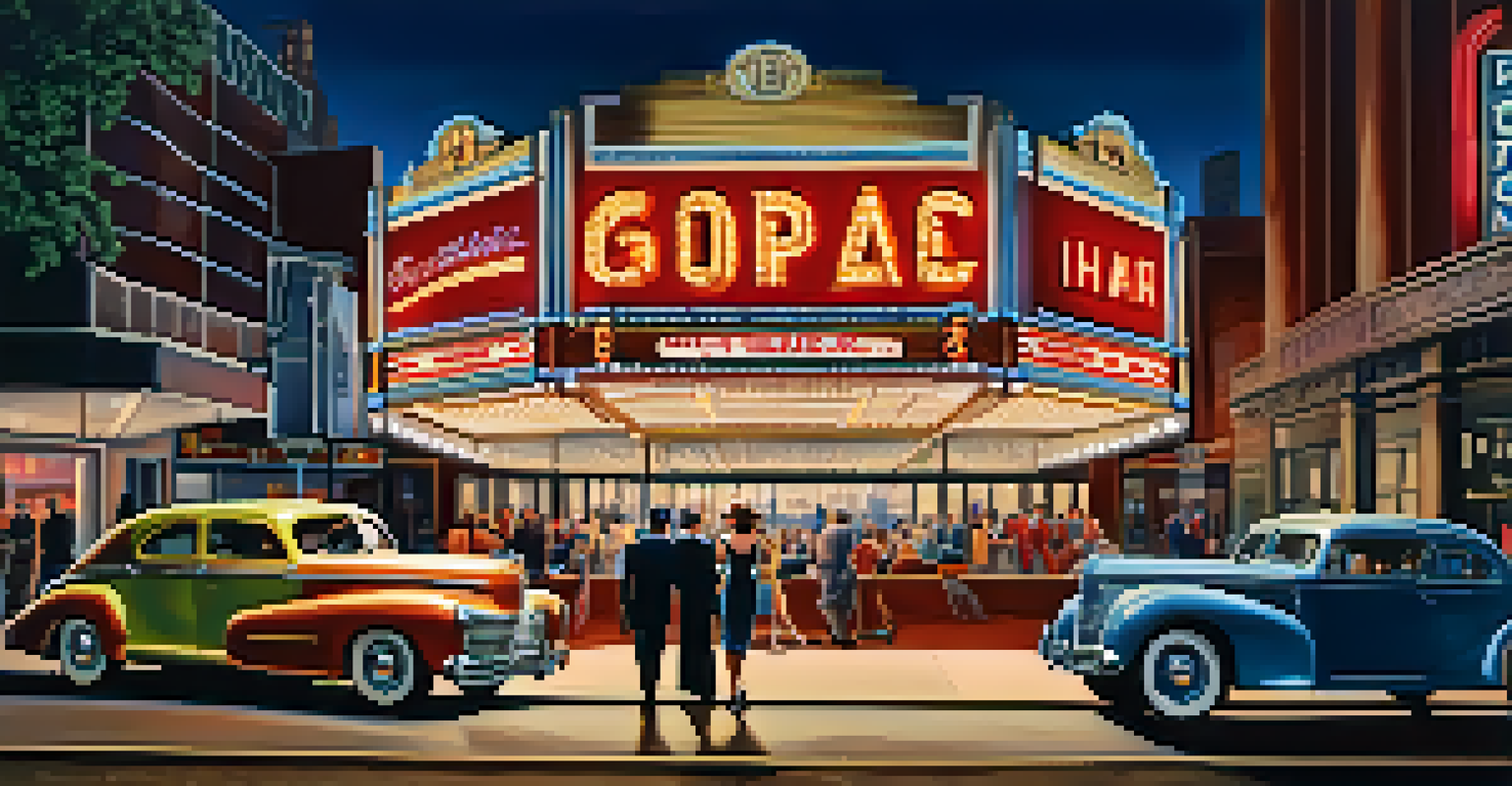The Hays Code: Hollywood's Response to Censorship in 1930

Understanding the Hays Code: Origins and Purpose
The Hays Code, officially known as the Motion Picture Production Code, emerged in the early 1930s as a response to growing concerns about the content of films. Before its implementation, Hollywood was facing backlash for its risqué themes and explicit content that many deemed morally objectionable. The code aimed to establish a set of guidelines that would ensure films adhered to social norms and values, effectively reshaping the industry.
The Hays Code was an attempt to impose a set of moral standards on films that reflected the values of the time, but it often stifled creative expression.
In a time when movies were becoming a primary source of entertainment, public outcry over scandalous depictions in films prompted the industry to self-regulate. The code was named after Will H. Hays, the president of the Motion Picture Producers and Distributors of America, who was tasked with creating a framework for acceptable content. It reflected societal attitudes of the time, focusing on the need for moral integrity in film.
The Hays Code's introduction marked a significant shift in Hollywood, where filmmakers had to navigate a delicate balance between artistic expression and compliance with these new regulations. This self-censorship not only influenced what stories could be told but also how they were presented, affecting everything from character development to plotlines.
Key Provisions of the Hays Code
The Hays Code comprised several key provisions that outlined what was acceptable in films. Among these were strict guidelines prohibiting nudity, suggestive dances, and any portrayal of sexual relations outside marriage. Furthermore, it mandated that crime should not be depicted in a way that might inspire imitation, ensuring that movies conveyed moral lessons rather than glorifying wrongdoing.

Another significant aspect of the code was its stance on religion, emphasizing that films should show respect for all faiths and avoid portraying clergy in a negative light. This provision reflected the cultural landscape of the time, where religion played a pivotal role in everyday life and moral guidance. By enforcing these rules, the code aimed to protect audiences from perceived negative influences.
Origins of the Hays Code
The Hays Code emerged in the 1930s to regulate film content and align it with societal morals.
These regulations shaped the creative landscape of Hollywood, compelling filmmakers to find innovative ways to tell their stories while adhering to strict guidelines. This often led to the use of subtext and innuendo, where filmmakers would imply themes without directly depicting them, adding a layer of complexity and cleverness to the narratives.
Impact on Filmmaking and Storytelling
The Hays Code had a profound impact on filmmaking and storytelling in Hollywood, leading to a distinct shift in how stories were told. Filmmakers were forced to become more creative, often using clever dialogue and visual symbolism to convey themes that would otherwise be censored. This ingenuity gave rise to a unique style of storytelling, often laden with double meanings and nuanced character arcs.
The restrictions of the Hays Code forced filmmakers to be more creative, leading to a unique style of storytelling laden with double meanings.
For instance, the film 'Casablanca' managed to portray themes of love and sacrifice, all while adhering to the code’s restrictions. Subtle hints and romantic tension were conveyed through dialogue and cinematography, showcasing how filmmakers adapted to the limitations set by the Hays Code. This adaptability not only enriched the storytelling experience but also laid the groundwork for future genres.
However, this also led to the frustration of many artists who felt stifled by the constraints. The limitations of the code often resulted in sanitized versions of reality, where complex social issues were glossed over or avoided entirely, leading to a longing for more authentic representation in cinema.
Public Reception and Criticism of the Hays Code
The Hays Code was met with mixed reactions from the public and critics alike. While some applauded the code for promoting moral values and protecting family-friendly content, others criticized it for stifling artistic expression and censoring important social issues. This division highlighted a cultural tension in America, as the nation grappled with changing social norms and expectations.
Many filmmakers and writers viewed the code as an infringement on their creative freedom, leading to a pushback against the restrictions. Notable figures in the industry, such as director Billy Wilder, famously flouted the code's rules, creating films that challenged its authority. This resistance paved the way for future discussions about censorship and the role of art in society.
Impact on Filmmaking
The code forced filmmakers to creatively navigate restrictions, leading to innovative storytelling techniques.
As societal values shifted throughout the decades, the code increasingly faced scrutiny, leading to calls for reform. Critics argued that the code was outdated and no longer reflected the realities of modern life, setting the stage for significant changes in the film industry.
The Hays Code and Gender Representation
One of the most significant areas affected by the Hays Code was gender representation in film. The code imposed strict limitations on how women were portrayed, often relegating female characters to traditional roles that aligned with societal expectations of femininity. This led to a narrow portrayal of women, often emphasizing their roles as homemakers or objects of desire.
While the code aimed to promote moral values, it inadvertently reinforced gender stereotypes, often sidelining complex female characters in favor of more simplistic portrayals. The lack of strong, independent women in films reflected broader societal attitudes, limiting opportunities for female filmmakers and writers. This created a cycle where women's voices were marginalized, both on and off-screen.
Despite these limitations, some filmmakers found ways to subvert the code, creating powerful female characters that challenged societal norms. By using clever writing and strong performances, these films managed to push back against the constraints of the code, highlighting the potential for more nuanced and diverse storytelling.
The Decline of the Hays Code
The Hays Code began to decline in the late 1950s as societal values shifted and the counterculture movement gained momentum. With changing social norms and growing resistance to censorship, filmmakers began to challenge the code's authority more openly. This period saw the emergence of films that tackled previously taboo subjects, reflecting a broader cultural shift towards greater openness and freedom of expression.
By the late 1960s, the code became increasingly irrelevant as filmmakers pushed the boundaries of what was acceptable in cinema. The rise of independent films and the influence of international cinema introduced audiences to a wider range of themes and storytelling techniques, further eroding the code’s influence. This culminated in the abandonment of the code in favor of a new rating system that allowed for more nuanced categorizations of film content.
Legacy in Modern Cinema
Although the Hays Code is obsolete, its influence on censorship and representation continues to shape today's films.
The eventual demise of the Hays Code marked a significant turning point in Hollywood history, paving the way for a new era of filmmaking that embraced diversity and complexity. This shift not only transformed the landscape of cinema but also signaled a broader acceptance of various narratives and perspectives in mainstream media.
Legacy of the Hays Code in Modern Cinema
Even though the Hays Code is no longer in effect, its legacy continues to influence modern cinema. The code's emphasis on moral standards and societal values has left an indelible mark on how filmmakers approach storytelling and character development. Many filmmakers still grapple with the balance between artistic expression and audience expectations, a challenge that echoes the conflicts of the past.
Moreover, discussions about censorship and representation in film remain relevant today, often revisiting themes that the Hays Code once restricted. Filmmakers continue to push boundaries, exploring complex social issues that reflect the realities of contemporary life. This ongoing dialogue around censorship and morality in film is a testament to the enduring impact of the Hays Code.

In reflecting on the Hays Code, we gain insight into the ongoing evolution of cinema and the importance of artistic freedom. By understanding the challenges faced by filmmakers in the past, we can better appreciate the diverse narratives that define modern cinema and the continuous quest for authenticity in storytelling.